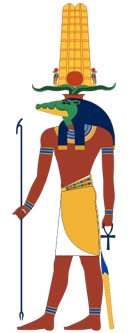Sobek | The Crocodile God Of Strength
Sobek is the ancient Egyptian god of strength and power. Some myths involve Sobek as the creator of the world, and the ancient Egyptians revered him as far back as the Old Kingdom. He gained celebrity status during the Middle Kingdom when King Amenemhat III took particular interest in the Crocodile God. This 12th Dynasty King gave Sobek a makeover when he merged his likeness with Horus.
The Crocodile God
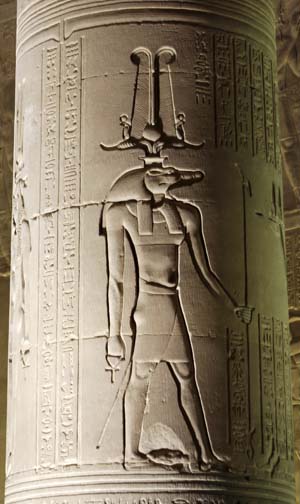
© Dain Sandoval - Temple of Kom Ombo
The people of ancient Egypt worshiped crocodiles while both loving and fearing them. They were a symbol of power, virility and fertility. As the Crocodile God, Sobek protected the Egyptian army, the pharaohs, and the ancient Egyptian people. His strength and courage allowed the Pharaoh to overcome obstacles and also protected him from evil magic.
Sobek first appeared in the Old Kingdom and is portrayed as a full crocodile or as a human with a crocodile head. The Ancient Egyptians kept crocodiles in pools and temples, fed them delicacies and bejeweled them. Mummified crocodiles of all ages have been found in tombs, including eggs with fetuses.
Benevolent Yet Unpredictable
Sobek is the God of the Nile because he controlled the waters and the fertility of the soil. He is known under several titles, such as “Lord of the Waters,” “The Rager,” and “Lord of Faiyum”. He is also patron of the Military because of his strength, power and prowess. As God of the Nile, Sobek took on the characteristics of the Nile crocodile whom the ancient Egyptians both loved and feared.
Crocodiles are ferocious, fearless creatures. Their abundance in the Nile reflects their reproductive abilities.
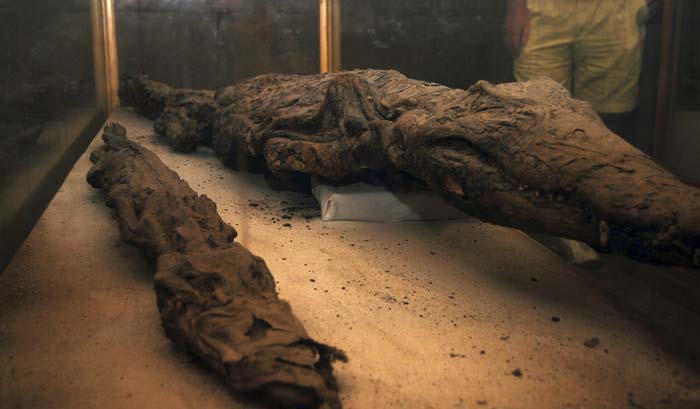
© Dain Sandoval - Mummified Crocodiles
Some of Sobek’s attributes include:
- Aggressive and Violent (thus his association with military prowess)
- Animalistic (in general, crocodiles operate on pure instinct)
- Unpredictable and erratic (the embodiment of a crocodile thrashing about)
- Overtly sexual (crocodiles flourished around the Nile)
- Strength and Power (military prowess, bodyguard of the Pharaoh)
- He could bring about sight and renew senses to the dead (the ancient people’s believed he could help them recover from a bad season)
- Protective (his ferocity enabled him to ward off evil and protect the innocent)
Sobek’s Not-So-Reptilian Family Tree
- Father: Set, the God of thunder, storms, war and chaos.
- Mother: Neith, the Goddess of war, hunting and wisdom.
- Wife: Sobek’s wife, Renenutet was the Goddess of Plenty and brought good fortune to the ancient Egyptians.
- Sons: Sobek is likely the father of Khonsu, the God of the moon and time. Sobek was sometimes also referred to as the father of Khnum and Khonsu.
- Cohorts: In addition to his wife, several cohorts existed including: Hathor, Heqet, and Taweret.
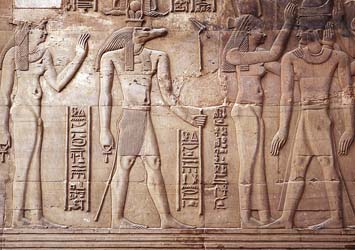
© Rhys Davenport - Hathor and Sobek
Crocodilopolis and other Cult Centers
Sobek was worshiped in several places, there following 3 being the most important cult centers:
- Shedyet: renamed Crocodilopolis by the Greeks. The ancient Egyptians worshiped a live crocodile named Petsuchos (son of Sobek). They decorated Petsuchos with precious gems and fed him only the finest foods. Petsuchos lived in a temple with sand and a lake, and when the crocodile died, the ancients mummified his remains. After that, another quickly took his place.
- Nubt: renamed Kom Ombo by the Greeks, this ancient city in Upper Egypt was a thriving military base with control over trade routes. Live crocodiles were kept at the Sobek temple where they were highly revered.
- Karanis: located in the NE corner of Fayum, this cult center was established under Roman rule and lasted until the year 380 under the rule of Emperor Constantine the Great.
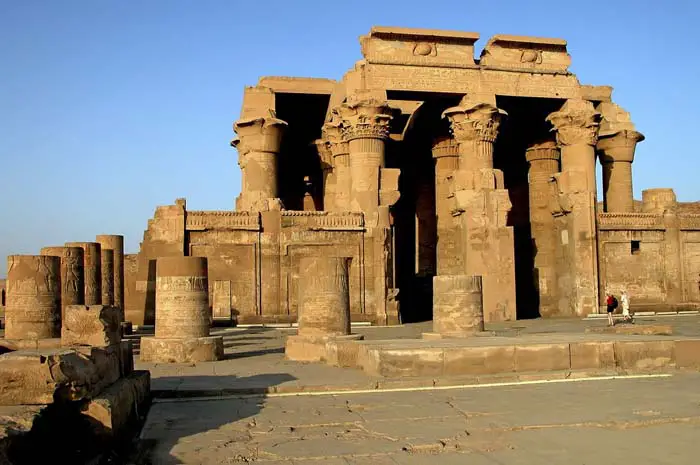
© Dennis Jarvis - Nubt, aka the Kom Ombo Temple
Associations and Triads
Sobek was closely related to Horus. Because Horus took the form of a crocodile to help retrieve parts of Osiris’ body, Sobek is often considered to be an aspect of Horus. And yet, Sobek was believed to have assisted Isis while giving birth to Horus. Sobek’s close association with Horus led to his adoption into the Osirian Triad comprised of Osiris, Isis and Horus.
During the New Kingdom, Sobek was worshiped as the manifestation of Amun-Ra, the King of Gods, and was integrated into the cult of Amun. Sobek was often depicted wearing Amun’s headdress or Ra’s sun disk.
Along with Hathor and Khonsu, Sobek was one of the three gods in the Triad of Kom Ombo, temples here were constructed between 300-380 BC and one can still be visited today.

© Mohamed - Sobek, The Crocodile God & Isis
Sobek Quick Facts
- Sobek is first mentioned in the Pyramid Texts, which are the oldest sacred texts in the world.
- Sobek rescued Horus’ four sons by gathering them in a net from the waters where they rose in a lotus bloom.
- Ancient Egyptians both loved and feared crocodiles, so their depiction of Sobek was a means to appease these ferocious creatures. In some places in Egypt they were worshiped, in other places they were hunted and killed.
- Sobek had a hand in the underworld. He could bring sight to the dead and enliven their senses. He also called on Isis and Nephthys to help protect the dead.

